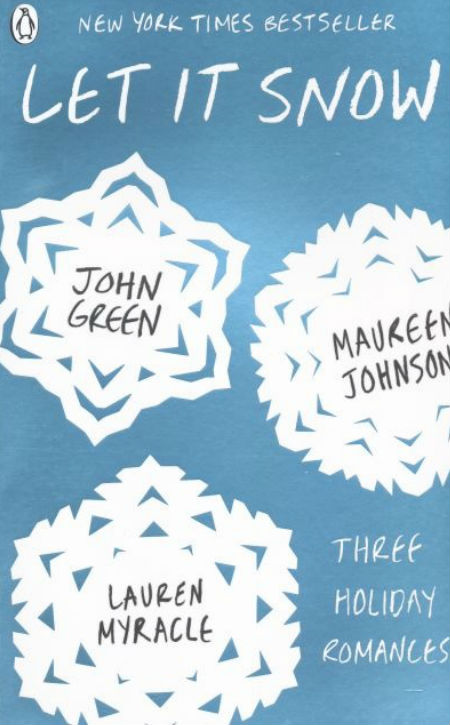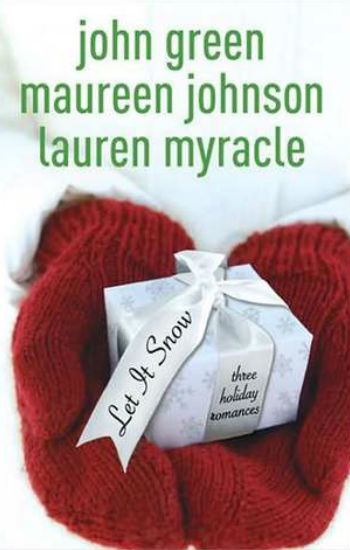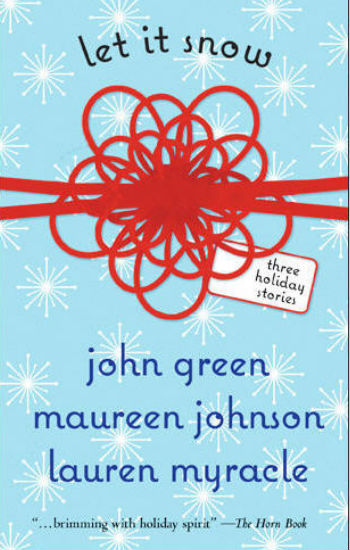
It has oft been said, most notably by songwriters Edward Pola and George Wylie in 1963, that Christmas is “the most wonderful time of the year.”
In its most romantic sense that’s probably true – how can you not be beguiled and cheered by chestnuts roasting on an open fire, caroling everywhere you turn, bright, festive decorations on trees, houses and streets and the prospect of spending time with those you love in a spirit of love and present-opening, eggnog-sipping bonhomie?
It’s all Normal Rockwell picture perfect, a fairytale writ colourfully large in red, green and white.
But despite our best efforts, and as the frenzy of gift-buying, decorating and partying would suggest, we give it everything we’ve got, not every Christmas manages to live up to this impossibly wondrous ideal, and it’s this idea, of an imperfect Christmas that doesn’t quite play out as planned, that forms the centrepiece of a collection of three holiday romances, Let It Snow, by three of the brightest voices in Young Adult literature, John Green, Maureen Johnson and Lauren Myracle.
Each contributes a story to the collection, all of which are interconnected in such a seamless and homogeneous way that their coordination must have involved copious Skype chats, a non-stop back and forth of carrier pigeons, or lunches at either Waffle House, Starbucks, or both (the selection of these two chains is not accidental; both feature heavily in the book).
However these three talented writers managed it, they succeeded in bringing together three quite different stories – although all of them take as their central idea the allure of unexpected romance and the possibility of the deliciously unexpected as their anchoring theme – and crafting them into a pleasing, escapist whole.
And that is what you need to keep uppermost in mind when you embark on reading these witty, playful and teenage earnest tales of love, romance and the dogged pursuit of Flobie Santa Village pieces and hash browns – even as they explore the unravelling of the archetypal perfect Christmas, they happily entertain the idea that romance, blushing, enervating, joyful, all consuming romance is waiting at the end of these frayed, initially dispiriting threads.

So in their own way they are just as much a fabricated ideal as anything dreamed up by Irving Berlin, Coca-Cola or Hallmark; even so thanks to the skill of these authors, all of whom have garnered devoted readerships with their tales of life and love at the coalface of teenage life, you never feel as if you are reading insubstantial stories of little import.
Sure they’re all punctuated by witty asides, hilariously-framed observations and the sort of clever word play that seems to characterise the preternaturally self-assured teenagers of Young Adult fiction, but they all Mean Something too.
Having said that, it’s worth remembering that Let It Snow is first and foremost good old escapist fun, as much an antidote to the harsh realities of day-to-day, January-to-November life as big band-sounding Christmas albums and It’s a Wonderful Life.
“We study there a lot because… what other choice does society give us, right? It’s Starbucks or death, sometimes.” (Maureen Johnson, “The Jubilee Express”)
Maureen Johnson’s kicks things off in “The Jubilee Express”, with the delightfully astute Jubilee, named after one of the pieces in the fictitious Flobie Santa Village collection, finding herself on a train to Florida to spend Christmas with her grandparents after her parents are arrested far from home trying to get the latest limited edition piece, the competition for which causes a riot.
She’s none too pleased to be wrenched away from boyfriend Noah’s family’s annual smorgasboard Christmas eve do, and even less happy when the train she’s on plows into a massive snowbank and refuses to go any further in the heavily-snowed in town of Gracetown, North Carolina.
Finding herself in a Waffle House with her fellow passengers, a squad of super-perky cheerleaders all named Amber or Madison, a lovelorn guy called Jeb and an eccentric local affectionately known as Tinfoil Guy, she is only too happy to take up the offer of “dedicated Target employee” – his self-applied description is entirely ironic and deprecatory – handsome yet geeky Stuart Weintraub to spend Christmas with his family.

“…a taste so profound and complex that it can’t even be compared to other tastes, only to emotions. Cheesy waffles, I was thinking, tastes like love without the fear of love’s dissolution…” (John Green, “A Cheertastic Christmas Miracle”)
Meanwhile in John Green’s “A Cheertastic Christmas Miracle”, easily the most assured and well told story of the three, close friends from childhood Tobin, The Duke (aka Angie) and JP Kim decide to drive to said same Waffle House at the urging of their other friend Don-Keun who sees great short term romantic possibilities in the seemingly endless cluster of Ambers and Madisons and believes that Tobin’s copy of the game of Twister will be his entree to a world of loving he has previously only dreamt of.
Naturally all this driving, and then walking, after Carla, Tobin’s parent’s SUV becomes the irresistible force meeting the immovable object of a snowbank, takes place in one of the worst snowstorms in fifty years, leaving the three friends, and particularly Tobin and The Duke, who may or many have a When Harry Met Sally conundrum standing like a Starbuck latte-sipping elephant in the room between them that they need to resolve.
“Christmas is never over, unless you want it to be… Christmas is a state of mind.” (Lauren Myracle, “The Patron Saint of Pigs”)
Finally Lauren Myracle gives us “The Patron of Pigs” in which an almost unlikeable protagonist Addie – she is redeemed in ways I won’t articulate here – newly broken up from a character we have already encountered in an earlier story, and desperately, morosely sad about it in a way that only first love teenagers can be, discovers that she may have a flaw or two she needs to address.
This tale, which isn’t as strong as Johnson’s or Green’s and seems to be trying a little too hard at first to generate the casual hip wittiness and cleverness that the first two stories seem to effortlessly give off in spades, nevertheless has some charm as Addie, fearing she has lost her one true love forever, comes to realise that looking beyond herself, and collecting a miniature teacup pig for her friend Tegan, may just be the answer to all her largely self-generated problems.
That all three stories end happily will hardly come as a surprise but the great skill of all three authors, apart from their impressively coordinated tying up of what initially seem to be unconnected tales, is that they manage to make the travails of their respective protagonists seem to be of weight-of-the-world importance while keeping alive the magical spark of the season.
The moral of all three stories seems to be that life can get unexpected messy and complicated especially during the holidays and may not meet our romanticised expectations, but that doesn’t mean to say that it still can’t be the most wonderful time of the year after all.